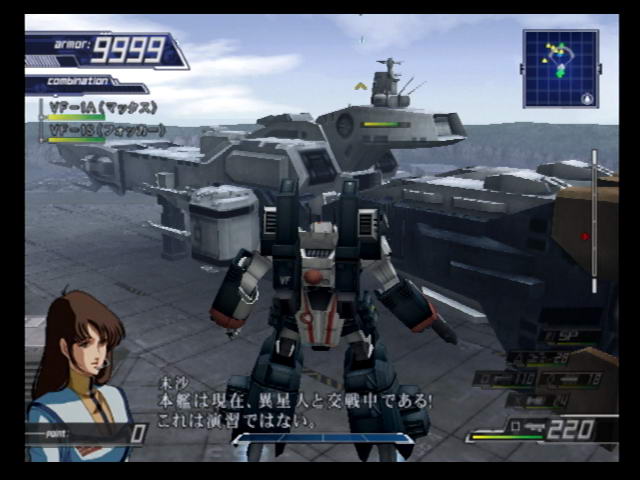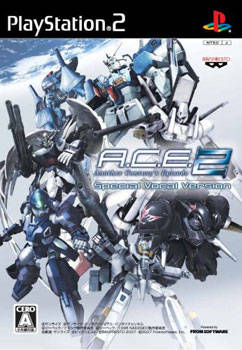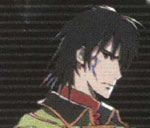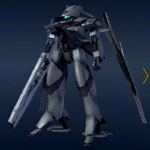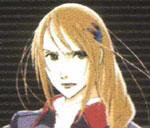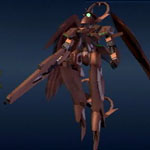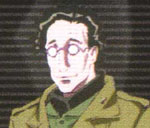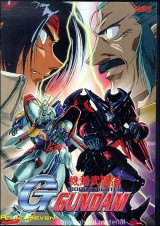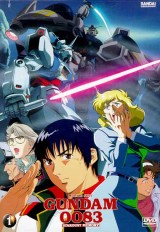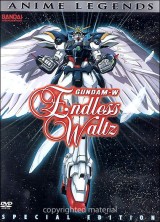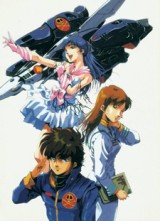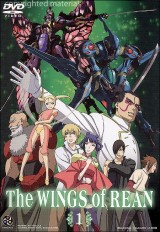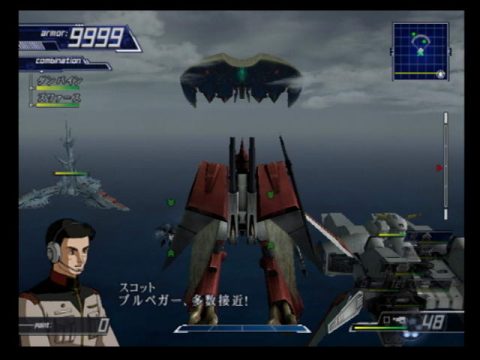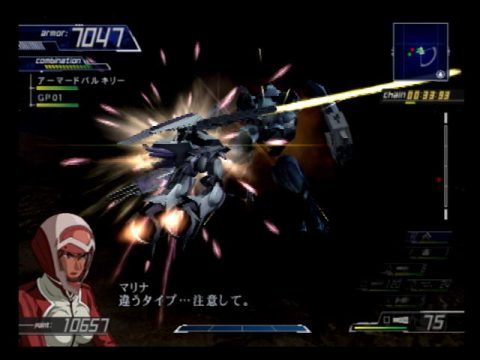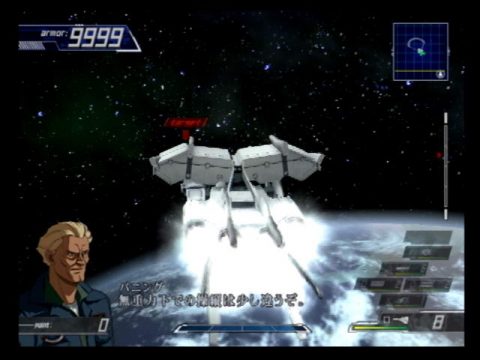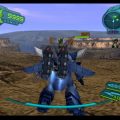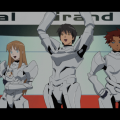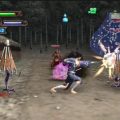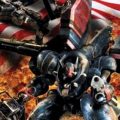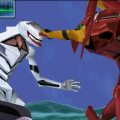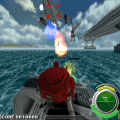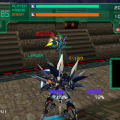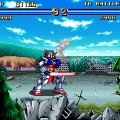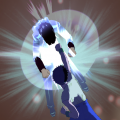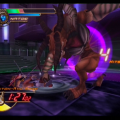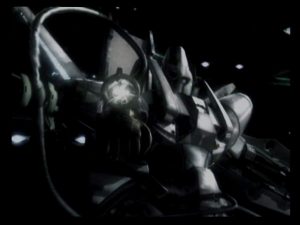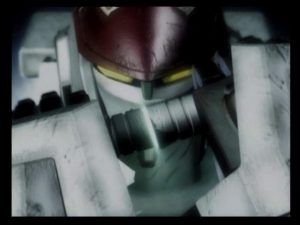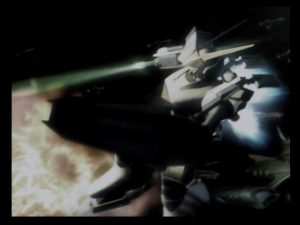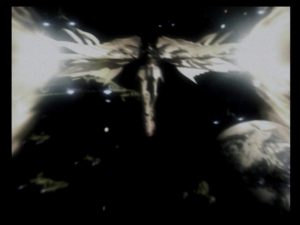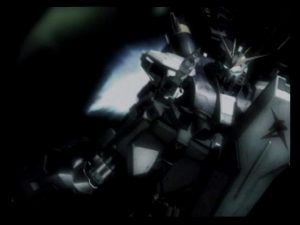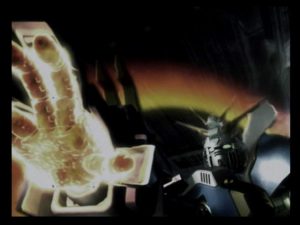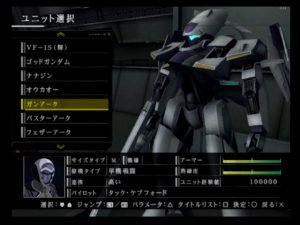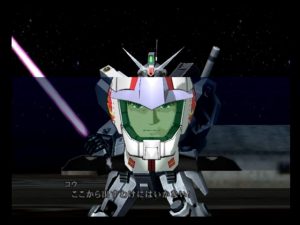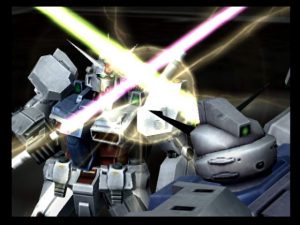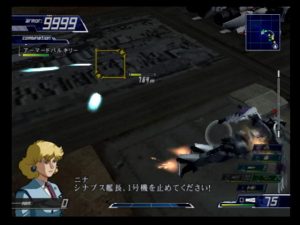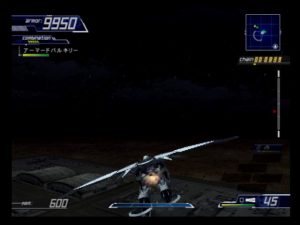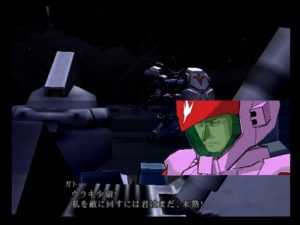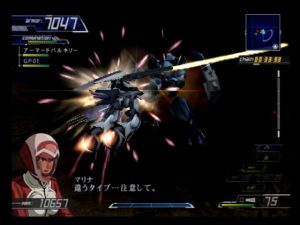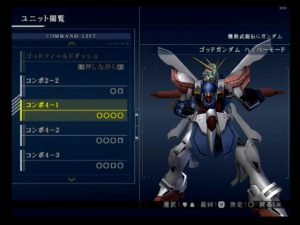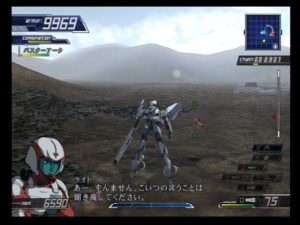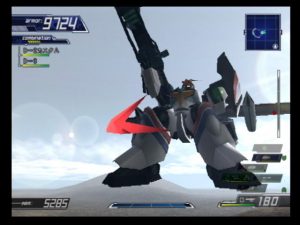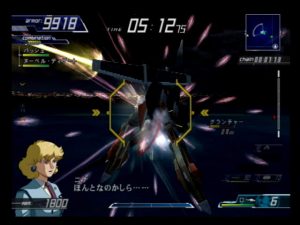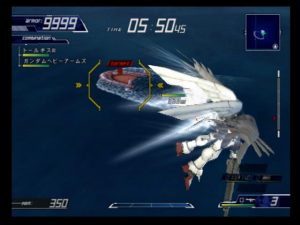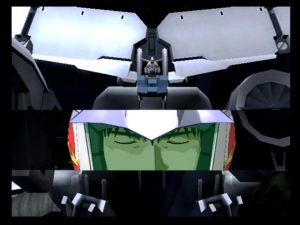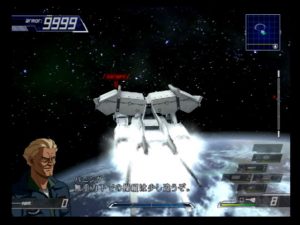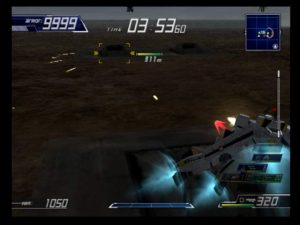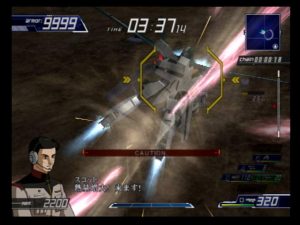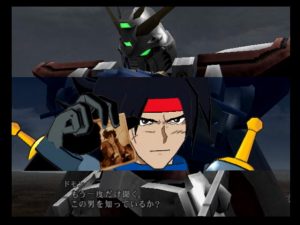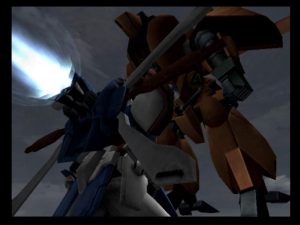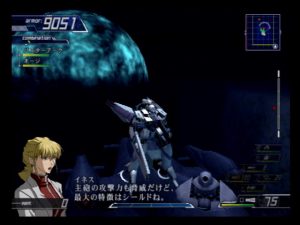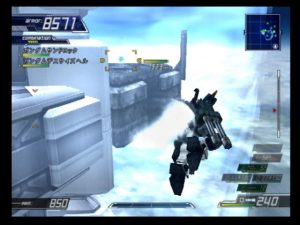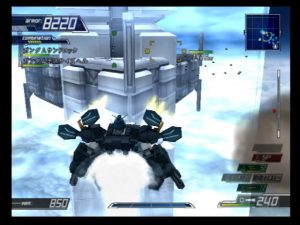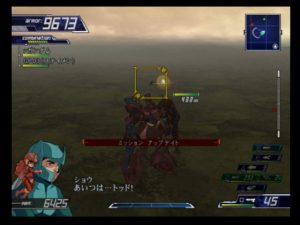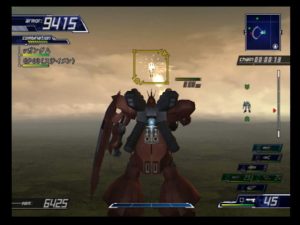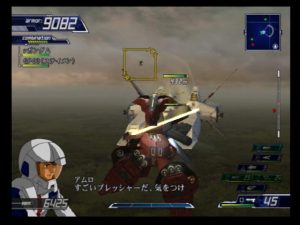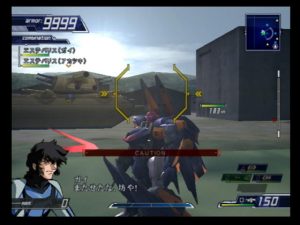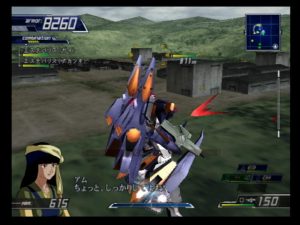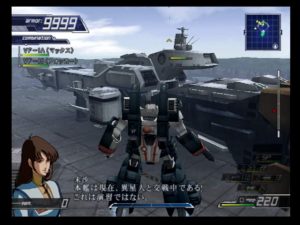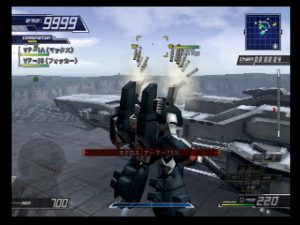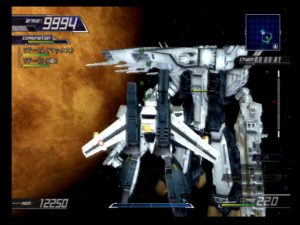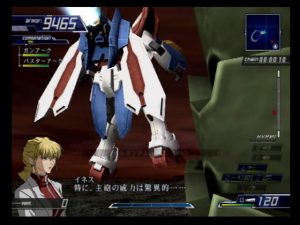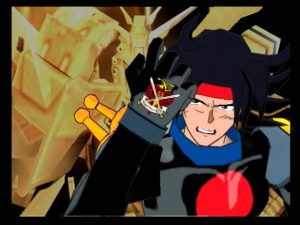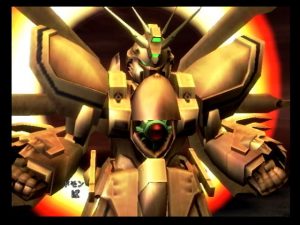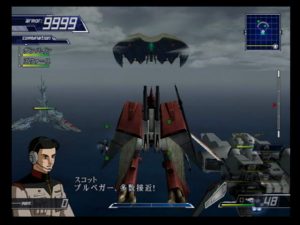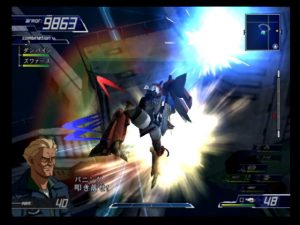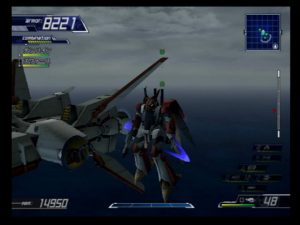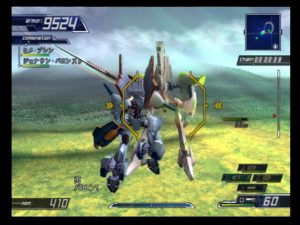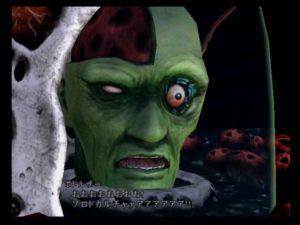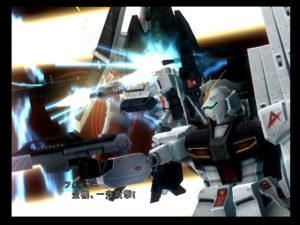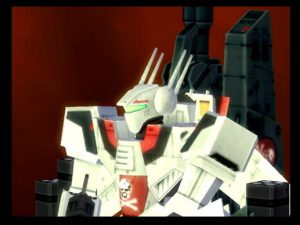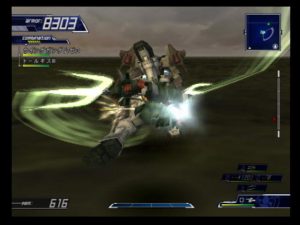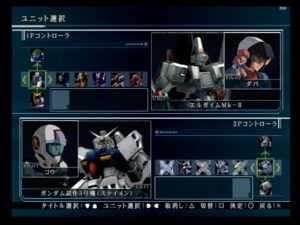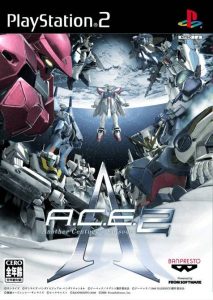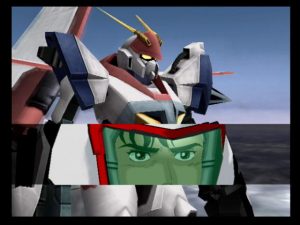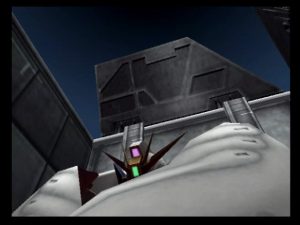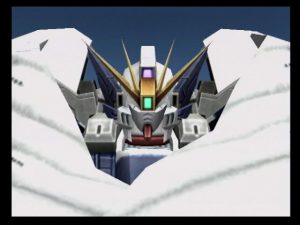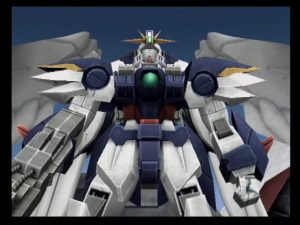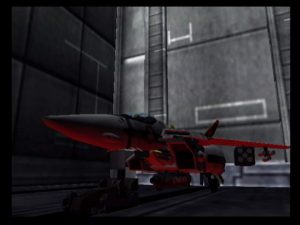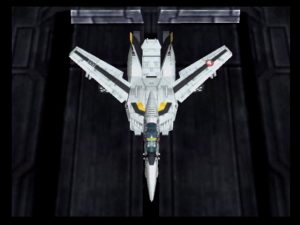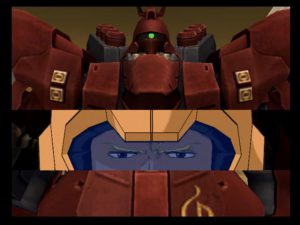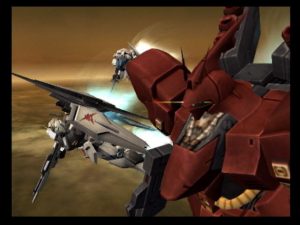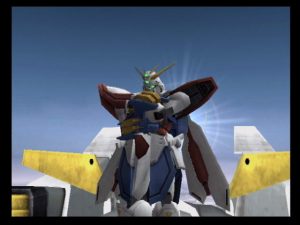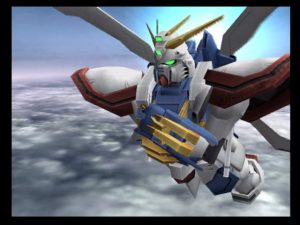- Another Century’s Episode
- Another Century’s Episode 2
Considering Banpresto & From Software’s track record, it’s not surprising they brought out a sequel a little over a year later. ACE2‘s plot takes place in a separate continuity from the first game. Zeta Gundam & Gundam Wing were taken out, and Prince of Darkness was relegated to unlockable extras status. Six new anime were added to the line-up for a total of thirteen. Returning shows also gained one or more new mecha to their playable line-up.
Tak Kepford
The main character. Tak is a test pilot for the Ark series mecha. Mostly calm but gets a bit emotional when it comes to Marina.
Gun Ark
The latest Ark series machine developed for use with the Guardian system. It has several powerful armaments and later gains the ability to attack enemies by becoming a beacon for an orbital satellite cannon (the Guardian system), making it quite broken. It can also transform into a fast and mobile flight form.
Marina Carson
Another test pilot and Tak’s comrade. Marina apparently sacrifices herself early on, but comes back later to antagonize you throughout the game.
Buster Ark
At first Marina pilots a normal red Gun Ark. She later comes back in this customized version. Her signature move is spinning and rapidly firing her gun at surrounding enemies, though ironically this move is more useful when used on single targets.
Martian Successor Nadesico
Plot Summary:
The predecessor to the Prince of Darkness movie featured in the first game. It tells the exploits of the crew of the privately-owned battleship Nadesico amidst a war between mankind and mysterious aliens situated on Jupiter.
Mecha:
Unlike the customized Aestivalis from the movie, the original Aestivalis use different frames for different combat situations. Standard armaments include machine guns, missiles, distortion fields and in a homage to super robots, rocket punches! Some frames are also environment-exclusive, meaning a frame only works in either space or Earth-based missions.
Mobile Fighter G Gundam
Plot Summary:
The story of G Gundam is set against the backdrop of a global tournament in which the winner’s nation will rule Earth for four years. Neo Japan’s fighter Domon Kasshu participates in the hopes of finding his missing brother who’s hiding on Earth with the Devil Gundam, an environmental repair machine gone berserk. Like in the Super Robot Wars series, the tournament plot is largely ignored here in favor of just pursuing the Devil Gundam.
Mecha:
Mobile fighters are mobile suits that attack primarily at close range with fists, feet and other melee weapons. The God Gundam is the only mobile fighter available, and its only opposition is the Devil Gundam and its huge Gundam-headed tentacles. It retains the standard mobile suit vulcans and beam sabers and has a two stage bar that fills up by destroying enemies. When it reaches Hyper Mode, it gains the Gundam equivalent of a shoryken and a shinku hadoken.
Mobile Suit Gundam 0083: Stardust Memory
Plot Summary:
This OVA takes place between the original show and Zeta Gundam. While the Earth Federation is testing newly developed Gundam mobile suits, one, which is equipped with a nuclear warhead, gets promptly stolen by Zeon. The carrier ship Albion and its crew are charged with retrieving it before the warhead gets used against the Federation.
Mecha:
The GP series Gundams are about as generic as you can get, packing the standard armaments of beam rifle, saber, vulcans and bazooka. One of them, however, can attach itself to a mobile armor add-on that’s stuffed to the brim with weapons. The assault carrier Albion takes over for the Ra Cailum as your flagship in this game.
New Mobile Report Gundam Wing: Endless Waltz
Plot Summary:
The Earth/colonies conflict from the TV series is over and peace is achieved. However, right after the Gundams are sent into the sun, a new rebel foundation pops up with yet another plan to drop a colony on Earth (Surprise!). Now it’s a race to retrieve the Gundams and stop the true Operation: Meteor.
Mecha:
The OVA replaces the upgraded Gundams from the TV show with the love’em-or-hate’em Hajime Katoki redesigns, which pushes the originals’ thematic appearance to the extreme. Wing Zero now has angelic-looking wings, while Deathscythe Hell’s cloak looks more like bat wings. Gameplay-wise, they’re not terribly different from their original counterparts in the first game.
Super Dimensional Fortress Macross / Do You Remember Love
Plot Summary:
A large alien ship crashes on Earth. 10 years later it’s repaired by humanity and ready for its maiden voyage. When civilian stunt pilot Ichijo Hikaru drops by to watch the event, he gets caught in an alien attack and a subsequent warp that sends everyone to the edge of the solar system. With the warp function disabled, the crew and citizens of the titular ship must journey back to Earth the hard way.
Mecha:
Of the two mecha types in Macross, only the valkyries are available for use, because the destroids are strictly walking tanks and no amount of artistic liberty can make them fly convincingly. The valkyries are basically transforming F-14s just a few meters below mobile suits in terms of height. Like metal armors they rely on machine guns and missiles as their main armament as well as a head mounted laser cannon, however their only means of close range attack is punching with their fists. Optional armor attachments give them increased missile firing abilities while FAST packs give them a back mounted beam cannon. They also share the heavy metals’ ability of multi-directional boosting.
Wings of Rean
Plot Summary:
Young civilian Aesap Suzuki gets taken to Byston Well by a mysterious princess who enlists his aid in stopping her warmongering father, a former Japanese kamikaze pilot who was sent there 70 years prior. This OVA is not part of the game’s plot and its units are just unlockable extras. Its story appears only in the third game.
Mecha:
Whereas the aura battlers from Dunbine were kinda bulky and modeled a bit after medieval knights, the ones in Wings of Rean are sleek samurai bugs with guns and flaming katanas. And yes, that’s as awesome as it sounds.
The game engine and graphics have been majorly revamped, with the already pretty mecha models given a new coat of gloss. The control scheme also received a slight modification. Instead of being context-sensitive, melee attacks are now assigned to the sub-weapon button, and holding the L1 button maps up to six weapons/abilities to the buttons on the right side of the controller. Unfortunately, this means that you have to give up half the control of your mech since the boost, altitude control and targeting functions are temporarily overwritten until you let go of the L1 button. It’s a pretty big sacrifice, but becomes tolerable with practice. This change also helped to make close-combat units more useful as they were a bit underwhelming in the first game. The alternate control scheme from the first game loses its reliability on target distance in favor of using the L1 button to cycle between your armaments ala ZOE. Although the weapon icons are now smaller, they’re color coded so you know which weapon has multi-target capabilities and there’s a small progress bar that shows how long it takes before they reload.
Other improvements include the ability to use machine guns to shoot down incoming missiles, the ability to dodge by dashing vertically, extended combos and Dynasty Warriors-style weapon clashes. Mecha can also earn experience points which count towards unlocking new combos and new forms. The first game’s bi-polar upgrade system was ditched for a more standard version, and there’s now a 3D viewer that’s lets you check out all the shiny ships and mecha in the game as well as view the attack animations of the playable roster. During intermissions you can also read news articles and emails from other characters on the status of the world. It makes for pretty nice immersion, if you can understand the moon language. Another much needed addition is the simulator that allows you test out your new toys before using them in actual missions.
In the first game, you had the option of deploying wingmen. But for some reason they never actually appear in the mission to assist you so the feature was kinda useless. ACE2 fixed this and added an extra perk: when a special gauge is filled by racking up kills (or having your armor in the red zone), you can lock on to a target and press L2 to perform a combination attack. You’re then treated to a short cutscene of your squad blowing the crap out of the poor recipient. Moreover, if you use certain combinations of mecha from the same show you’ll get special cutscenes that do even more damage. Very useful for bosses early on.
When starting, the first thing veterans of the original will notice is the exponentially increased ammo count. There’s also an emphasis on multi-lock missiles and charge attacks which only a handful of units could do in the first game. This gives a false sense of security and tricks players into thinking the game is easy until they realize the reason for all the extra munitions. See, the enemies, especially the Zendrati from Macross, come at you in swarms that never let up on the barrage of deadly fire. Add to that the possible threat of a boss at the end and most people will end up finishing a mission with less than half their armor, so not running out of ammo so fast is a brief comfort. Further compounding the difficulty is the limitations of the targeting system, which makes it cumbersome to select the proper enemy while the rest pepper your back with bullets. This first becomes apparent when you tackle an orbital elevator stretching high above the stratosphere. Since the towering structure is a huge mess of targets, the only way to target the enemies defending it is to turn around completely and move away from the elevator, which puts you right in the crosshairs of the long range cannons at the top of the blasted construction. That was one of the very few times I ever had to rely on the new items feature, which allows you to select a single one-time use restorative or enhancement module to take with you on a mission.
Some mecha now have one or more extra forms which gives them modified stats or new attacks. In the case of armor attachments, it’s possible in a few cases to purge the extra stuff during the mission with L3+R3, which was reserved for special attacks or transformations in the first game. As mentioned before, certain forms work only in either Earth missions or space missions in keeping with the mostly accurate presentation of the mecha.
Speaking of presentation, the style and series interaction is much improved over the first game. Whereas characters never appeared in cutscenes in ACE, here they’re rendered with nice looking, if somewhat bright, cel shading. One of my favorite parts of playing Super Robot Wars games is seeing how G Gundam gets introduced into the plot, which usually happens in one of two ways: either the Devil Gundam pops up in the middle of a battle with Domon chasing after it, or Domon interrupts a fight and starts asking everyone if they’ve seen his brother. The latter case is what happens in ACE2, where Domon casually destroys an enemy long range cannon used to bombard the player during a mission then proceeds with the questioning, followed by him incinerating the poor grunt who tried to attack him with his God Finger attack.
ACE2 is not perfect, however. Despite having a whooping 72 missions, about eighty percent of them fall under the same repetitious mold. There are far too many missions where escorting and protecting a ship is either a primary or secondary objective, and this is a recipe for frustration because several secret objectives require keeping your ship’s health above a certain level or getting it to a destination under a time limit. It’s one thing to run out of ideas but it wouldn’t have killed Banpresto and From Software to reuse some of the more interesting missions from the first game. Another sore point is that From Software hasn’t addressed the issue of figuring out your headings in space missions. It doesn’t actually detract from the gameplay, since most of the time you’re automatically propelled in the direction of your target or have a big 3D arrow pointing towards the objective. However, there were a couple of secret objectives in the first game that required finding a target at the edge of the map and destroying it before it disappears. This was mostly a minor annoyance, but it’s pretty glaring in ACE2. In one mission, for example, the secret objective is to destroy several unmarked ships on the map with no clue where to find them except a static 3D map in the pause menu, which has no interest in telling you which direction you’re facing. It’s bad enough when you’re trying to squint your eyes against the bland space backgrounds, but that particular stage’s background is very busy. The soundtrack also takes a bit of a dip because the opening tracks of some of the shows don’t really lend themselves well to exciting battle themes. While this is really a matter of preference, I have to question decisions like using a somewhat calm piano and violin piece like “White Reflection” as Endless Waltz’s theme while omitting the faster tempoed and far more appropriate “Last Impression”.
The biggest disappointment has to be the anti-climatic finale. The final level is two back-to-back stages of blasting endless Zentradi waves followed by a quick trip through the corridors of their capital ship to find the Zentradi commander Bodolza and kill him…in a cutscene. Yes, we all know that he didn’t put up much resistance in the movie, but first of all, this is a video game, and second, you fought Bodolza in both the Banpresto Macross arcade shooter and the 3D Sega AM2 Macross game, so why not here? Has From Software realized at the last minute that they focused too much on the combat and couldn’t do something creative for the last boss? A darn shame.
Finishing the game once again opens up Free Mission mode and Extra Mission 1 & 2. They’re joined by Extra Mission 3 and standalone duels against the main mech(s) from each represented series. Extra Mission 3 is a survival challenge where you take on endless hordes of Serpents (the grunt mecha from Endless Waltz). Also, any mech with a full experience bar gives you the option of turning off its limiter (for a price), giving it unlimited ammo for most of its weapons. It kind of permanently breaks the game, but it’s still a lot of fun.
To capitalize on the popularity of the vocal tracks added to the third game, ACE2 was re-released as a Special Vocal Version containing vocal tracks for its series roster, but due to some convoluted licensing issues the opening theme “Glorious” was lost in the process. The two versions are identical otherwise, so there’s not much point to getting the new version if you’ve played the original unless you REALLY like the soundtrack.
